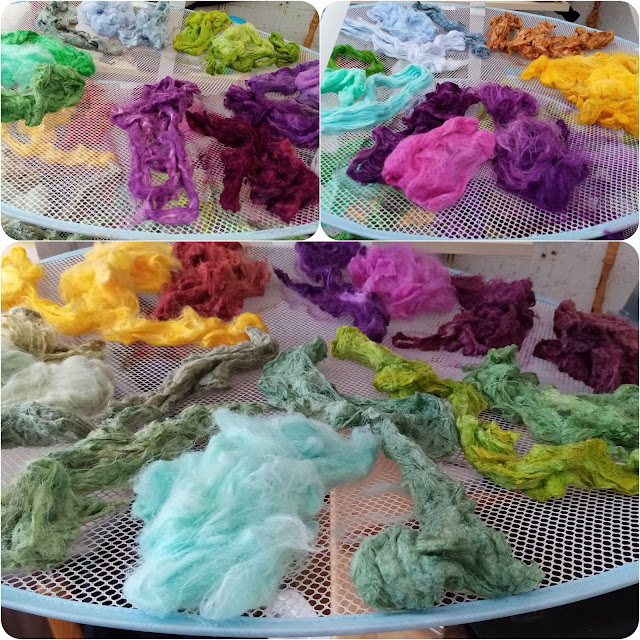I've had a full day in the kitchen playing with a variety of plant and cellulose fibres and some cold water dyes. My usual Greener Shades Dyes are not suitable for this kind of fibre and I now have quite a lot of it thanks to the two years of Advent Calendars and the occasional purchase by me, like the lap waste bags and a sample pack.
I've bought some small packs of cold water hand-wash dyes by Dylon, they also do dyes you can use in the washing machine, I don't want those. It doesn't say on the packets but working things out logically you can actually just use the amount of dye you need to use for the amount of fibre and keep the rest for later, you just need to be able to seal the packets up in between uses. I have some food packet clips from Ikea which are really good and provide a nice tight seal. You can also mix the dye colours to make new colours and shades, like my usual dyes, again it doesn't mention this on the packets but it does work.
Each 50g packet dyes up to 250g of fabric or fibre. The instructions say to weigh and then soak the fabric or fibre and to dissolve the whole pack of dye in 500ml of warm water. Weighing the fabric seems like a daft instruction amongst the rest of the instructions to me, other than to make sure that what you are dyeing is less than 250g, because you would only weigh the fibre if you are weighing out the dye to achieve a specific depth of colour and these instructions are assuming you don't care about the finished shade or depth of colour, just shove all of the dye in and hope for the best. It then says to fill a bucket or sink with 6 litres of warm water. Next you have to add 250g of salt followed by the dye and then the fabric or fibre. Stir for constantly for 15 minutes followed by regularly stirring for 45 minutes. Rinse in cold water and its done.
My revised instructions for enabling these dyes to be used in smaller amounts is as follows:
- use 1g of dye for every 5g of fibre
- Dissolve the required amount of dye in 10ml of warm water for every 1g of dye
- use 5g of salt for every 1g of dye
- add the dissolved dye to a further 120ml of warm water for every 1g of dye
- add the fibre and stir
- rinse in cold water after being in the dye for about an hour
So, the fibres that I have dyed are:
I also planned to dye a 10g sample of Egyptian Cotton, which I don't have a before photograph of and I have over-dyed two pink fibres that I have in my stash, 11g of pink Bamboo and 75g of Pink Soybean/Soysilk. The pink soybean isn't too bad a shade of pink but I do have quite a lot so I have split it into 3 lots, keep one in the original pink and dyed the other two lots.
My "dye pots" are re-cycled plastic take-away tubs and these hold enough dye to dye roughly 30g-35g of fibre. The dye colours that I have used are Vintage Blue, Deep Violet, Tropical Green and Sunshine Yellow. The results are not always what I expected but I am dying this fibre purely to put into my "ingredients cupboard" in a variety of colours. The fibre base colour will have an affect on the final result, especially the Soybean. The Mint fibre is a kind of pale mushroom colour in real life so that is likely to have a bit of an affect on the results too.
There were 16 "dye pots" throughout the course of the day and most of them had 3 different types of fibre in them. All of the fibres were soaked in warm water with the addition of a small amount of Synthropol prior to being put in the dye to remove any finishes that may have been on the surface of the fibre.
The Soybean, Trilobal Nylon, Hemp and Faux Cashmere/Bio-Nylon are larger amounts and have been pulled into lumps of about 10g each. The other fibres that I am dying from scratch are 25g samples htat have been split roughly in half to be dyed two different colours. I will let the following photos tell you all need to know. Where there is no percentage figures on the dye photos means that it was 100% of that colour. I have only put percentage figures where I mixed the colours in those proportions.
I'm pretty happy with my dyed fibre. The Soybean/SoySilk fibres didn't take the dye too well on the first attempt and I went back through and re-dyed them in the same colours as the first time around but this time it was on its own in the dyepot. I also over-dyed the Trilobal Nylon and the Faux Cashmere/Bio-Nylon blend that had turned out bright pink from the Deep Violet dye.
I will write a separate post to discuss the results, as this one is long enough already.



















No comments:
Post a Comment